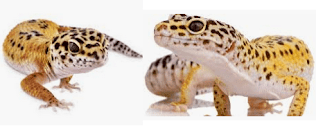Leopard Geckos (eublepharis macularius) are native to regions of Pakistan, Northern India, Iran, Iraq, and Afghanistan. An average adult’s length can range from 7-9 inches and they have a lifespan of up to 18 years.
Leopard Geckos continue to be one of the most popular geckos because of their easy care, docile nature, and wide variety of morphs available. Unlike other geckos, Leopard Geckos can open and close their eyes.
They are typically active during dusk and dawn hours but move about during the daytime too. Leopard Geckos do shed their skin and their tails are fragile so be careful when you hold them.
We recommend an under-tank heater for controlling the cage temperature as these nocturnal geckos do not typically bask under a heat lamp.
Since Leopard Geckos are nocturnal, they do not require UVB lighting. However, studies are reporting on the benefits of low-level exposure to UVB.
Leopard Geckos in their natural habitat are exposed to UVB over short periods, however, since they absorb UVB at a higher rate than diurnal reptiles-providing UVB on a daily or short-term basis is not recommended. In short, no UVB is required.
Regular household light bulbs can be used to boost heat and provide light - wattage is determined by the ambient room temperature where the gecko is housed. Reptile-specific UVA light bulbs provide an extended spectrum that allows reptiles to see more clearly in their environment.
Some hobbyists argue that since they are nocturnal, this is unnecessary, while others argue that their geckos are active during parts of the day and do benefit from the added UVA spectrum.
The juveniles will eat medium-sized crickets, mealworms, and wax worms. Adults will eat large crickets, wax worms, mealworms, and pinkie mice. Dust crickets lightly with vitamins and powdered calcium supplement every other feeding.
Juvenile leopard geckos should be lightly misted twice weekly to help them shed their skin.
General Information
All in-store leopard geckos are from captive-born and bred sources.Leopard Geckos continue to be one of the most popular geckos because of their easy care, docile nature, and wide variety of morphs available. Unlike other geckos, Leopard Geckos can open and close their eyes.
They are typically active during dusk and dawn hours but move about during the daytime too. Leopard Geckos do shed their skin and their tails are fragile so be careful when you hold them.
General Care
Enclosure
A 10-gallon aquarium with a vented lid is recommended for one Leopard Gecko. If you are housing two or more together, a 20-gallon aquarium is needed. Males will need to be housed separately.Substrate
Depending on the age and length of your gecko, use sand, reptile carpet, or paper. If you use an under-tank heating pad, be sure to have a reptile carpet underneath your substrate (sand) to protect your geckos from lying on the heated glass.Habitat
Decorate the aquarium with non-toxic plants, branches, logs, and cork. Include small hiding places for your gecko. Also, include dampened sphagnum moss in the hiding spot to help with shedding and keep them hydrated by misting them with dechlorinated water 2-3 times per week (keep in mind relative humidity/time of year).Temperature
The temperature during the day should be kept around 80-82° F with a warm area of 85-90° F. Night temperature can be as low as 70° F. Humidity levels should be kept low beside the hiding spot. Keep the hiding spot around 80° F.We recommend an under-tank heater for controlling the cage temperature as these nocturnal geckos do not typically bask under a heat lamp.
Lighting
Leopard Geckos need 10-12 hours of light per day to regulate a day/night environment. Use a lamp timer to help keep you both on a regular schedule.Since Leopard Geckos are nocturnal, they do not require UVB lighting. However, studies are reporting on the benefits of low-level exposure to UVB.
Leopard Geckos in their natural habitat are exposed to UVB over short periods, however, since they absorb UVB at a higher rate than diurnal reptiles-providing UVB on a daily or short-term basis is not recommended. In short, no UVB is required.
Regular household light bulbs can be used to boost heat and provide light - wattage is determined by the ambient room temperature where the gecko is housed. Reptile-specific UVA light bulbs provide an extended spectrum that allows reptiles to see more clearly in their environment.
Some hobbyists argue that since they are nocturnal, this is unnecessary, while others argue that their geckos are active during parts of the day and do benefit from the added UVA spectrum.
Food and Water
Provide clean, fresh chlorine-free water in a shallow bowl that cannot be tipped over. Feed your adult Leopard Gecko every two to three days. Juvenile Leopard Geckos will eat small crickets and mealworms daily.The juveniles will eat medium-sized crickets, mealworms, and wax worms. Adults will eat large crickets, wax worms, mealworms, and pinkie mice. Dust crickets lightly with vitamins and powdered calcium supplement every other feeding.
Juvenile leopard geckos should be lightly misted twice weekly to help them shed their skin.




